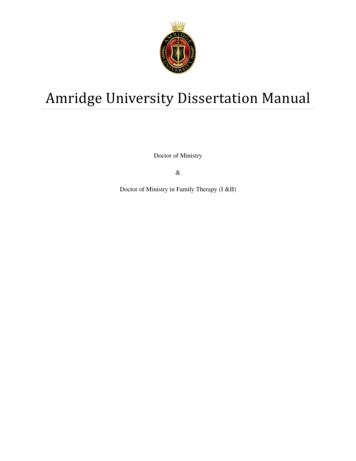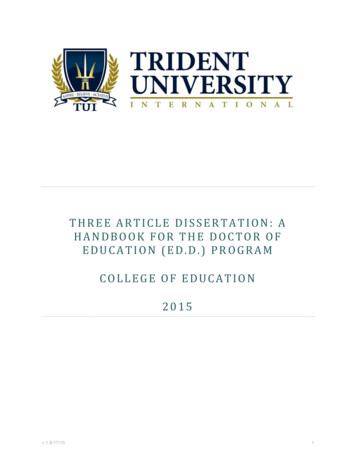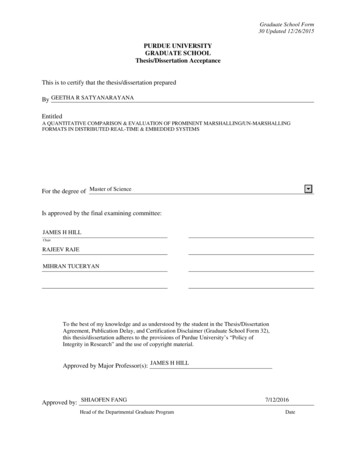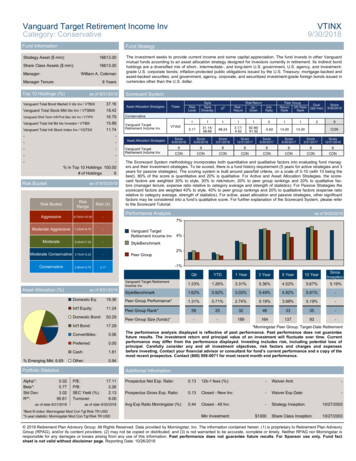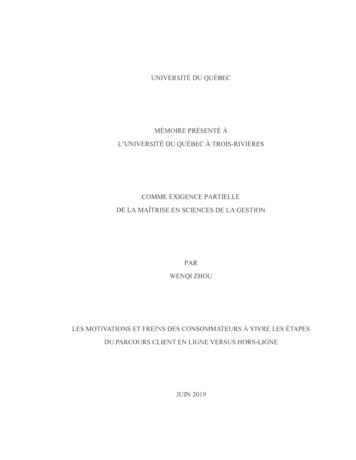
Transcription
HEC MONTRÉALÉcole affiliée à l’Université de MontréalBoard Diversity and Corporate Social Performance:A Review and Empirical InvestigationsparGokhan TurgutThèse présentée en vue de l’obtention du grade de Ph. D. en administration(option Management)Février 2017 Gokhan Turgut, 2017
HEC MONTRÉALÉcole affiliée à l’Université de MontréalCette thèse intitulée :Board Diversity and Corporate Social Performance:A Review and Empirical InvestigationsPrésentée par :Gokhan Turguta été évaluée par un jury composé des personnes suivantes :Alex BitektineHEC MontréalPrésident-rapporteurTaïeb HafsiHEC MontréalDirecteur de rechercheRick MolzConcordia UniversityMembre du juryJean B. McGuireLouisiana State UniversityExaminatrice externeMarc Antonin HennebertHEC MontréalReprésentant du directeur de HEC Montréal
Board Diversity and Corporate Social Performance:A Review and Empirical InvestigationsRésuméCette dissertation a été conçue pour faire la lumière sur les effets de la diversité des conseilsd’administration (CA) sur la performance sociale des entreprises (PSE). J'essaie d'atteindre cetobjectif à travers trois essais. Dans le premier, sur la base d'une revue de littérature, j'étudiethéoriquement la relation Diversité du CA-PSE et je propose des hypothèses. Dans le deuxième,je teste les hypothèses proposées en utilisant un échantillon d’entreprise cotées sur le marchéboursier américain. Dans le troisième, j'étudie si la relation entre la diversité des conseilsscolaires et leur PSE demeure stable au fil du temps.Dans le premier essai, je discute les différentes définitions de la diversité des CA dansla littérature. Après avoir effectué une revue systématique de la littérature, je montre que (1) leschercheurs utilisent des définitions différentes pour la diversité des conseils et de laperformance sociale. Ils construisent leurs définitions de la diversité en utilisant, sans distinguerparmi celles-ci, des variables représentant à la fois la structure et la composition du conseil. Demême, les conceptualisations de performance sociale sont également très différentes; (2) leschercheurs utilisent des outils différents pour mesurer la diversité des conseils d’administration.Ils utilisent à la fois des mesures tantôt quantitatives et tantôt qualitatives; (3) les chercheursmesurent aussi la performance sociale différemment. Parfois, ils considèrent la responsabilitésociale d'entreprise de manière générale (RSE) comme une mesure de la performance socialede l'entreprise. À d'autres moments, ils utilisent des composantes distinctes de la RSE. Dans cepremier essai, je propose de clarifier la diversité des CA en distinguant entre la « diversité desCA », qui mesure les différences de structure du conseil et la « diversité dans les CA », quimesure les différences entre les administrateurs en utilisant des variables qui caractérisent lesmembres du conseil d'administration (sexe, éducation, expérience .).L'objectif du deuxième essai est de fournir des preuves statistiques de la relation entrela diversité des conseils et le PSE à l'aide d'un échantillon d'entreprises manufacturières et deservices cotées sur le marché boursier américain. Je mesure la diversité des conseils et la diver-
sité dans les conseils en utilisant des indices de diversité que je développe. J'ai trouvé que (1)la diversité des conseils a un résultat négatif sur la PSE, et (2) la diversité dans les conseils a uneffet positif significatif sur le PSE. De plus, je trouve aussi que (3) la diversité des conseilsmodère positivement la relation entre la diversité dans les CA et le PSE. En outre, en utilisantles composantes de chaque indice de diversité, j'ai constaté que la taille du conseil(positivement), l’actionnariatdesadministrateurs(négativement), le sexe féminin(positivement), l’éducation des directeurs (positivement) et l’ancienneté des administrateurs(positivement) affectent la PSE.Le troisième essai étudie si la relation entre la diversité des CA et le PSE est stable. Pourcela j’examine si les changements de diversité entrainent des changements similaires dans laPSE. Mes résultats étaient marginaux et montrent que les changements dans la diversité desconseils ont un effet négatif significatif sur les changements dans la performance sociale desentreprises. Cependant, parmi les composantes de la diversité des conseils, les changementsdans l'indépendance des administrateurs ont un effet positif important sur les changements dansla performance sociale de l'entreprise.En résumé, j'ai essayé de répondre à la question de recherche : Dans quelle mesure ladiversité des conseils affecte-t-elle la PSE ? En arguant que (a) la diversité des conseils estdouble, avec une diversité structurelle et une diversité compositionnelle des membres du CA,je montre que (b) la diversité des CA et la diversité dans les CA, ainsi que leurs interactions,influent sur la PSE; et (c) ces relations sont stables dans le temps. Cette thèse contribue à lalittérature sur la stratégie et la gouvernance d'entreprise en clarifiant les définitions et lesmesures et en montrant que la composante structurelle de la diversité des CA a un effet quidiffère de la diversité compositionnelle dans les CA.Mots clés: Conseil d'administration, diversité, structure, composition, matrice de diversité,performance sociale de l'entrepriseMéthodes de recherche: Analyse de contenu, recherche quantitativeiv
Board Diversity and Corporate Social Performance:A Review and Empirical InvestigationsAbstractThis dissertation has been built to shed light on the effects of board diversity on corporate socialperformance (CSP). I try to achieve this goal in three essays. In the first, I study the relationshiptheoretically, and propose hypotheses on the basis of a literature review. In the second, I testthe proposed hypotheses relating board diversity and CSP. In the third, I investigate whetherthe relationship between board diversity and CSP remains stable over time.In the first essay, I discuss the different definitions of board diversity in the literature.After conducting a systematic literature review, I show that (1) researchers use differentdefinitions of both board diversity and social performance. They build their definitions of boarddiversity around variables representing both board structure and composition, withoutdistinguishing between these. Similarly, social performance constructs are also widely different;(2) researchers measure board diversity differently. They use both quantitative and qualitativemeasures; (3) researchers measure social performance differently. Sometimes they take themore general corporate social responsibility (CSR) as a measure of corporate socialperformance; at other times, they use distinct components of CSR. In this first essay, I proposeto distinguish between diversity of boards, which takes into account board structure variables,and diversity in boards, which uses board members’ compositional variables (gender, education,experience, etc.).The aim of the second essay is to provide statistical evidence of the relationship betweenboard diversity and CSP using a sample of service and manufacturing firms listed on the USstock market. I measure diversity of boards and diversity in boards using diversity indices thatI introduce. I have found that (1) diversity of boards has a negative, and (2) diversity in boardshas a positive significant effect on CSP. Additionally, I have also found that (3) diversity ofboards positively moderates the relationship between diversity in boards and CSP. In addition,using the components of each diversity index, I have found that board size (positively), directorownership (negatively), director gender (positively), director race (positively), and directortenure (positively) affect CSP.v
The third essay investigates whether the relationship between board diversity and CSPis stable overtime. The results were marginal. I found that changes in diversity of boards has anegative significant effect on changes in corporate social performance. Furthermore, amongcomponents of board diversity, changes in director independence has a positive significanteffect on changes in corporate social performance.In sum, I have tried to answer the research question of the dissertation (i.e., to whatextent does board diversity affect CSP?) by (a) arguing that board diversity covers both boardstructure (i.e., diversity of boards), and board composition (i.e., diversity in boards); (b)showing that both diversity of boards and diversity in boards, and their interactions, affect CSP;and (c) showing that these relationships are stable over time. This dissertation contributes to thestrategy and corporate governance literatures by clarifying definitions and measurements, andshowing that the structural component of board diversity has an effect, which differs from thecompositional component of board diversity.Keywords: Board of directors, diversity, structure, composition, diversity matrix, corporatesocial performanceResearch methods: Content analysis, quantitative researchvi
Table of ContentsRésumé . viiAbstract . vList of Tables . xiiList of Figures . xvList of Appendices . xviList of Abbreviations . xviiAcknowledgements . xix1.2.Introduction . 11.1Motive for Research . 11.2Background of Research . 21.3Statement of Problem . 41.4Aim of Research . 71.5Research Questions . 71.6Significance of Research . 81.7Structure of Research . 91.8References . 11Conceptual Study (First Essay) . 132.1Introduction . 142.2Theoretical Framework . 162.2.1Responsibilities of Board of Directors . 162.2.1.1 Boards’ Monitoring Responsibility and Agency Theory . 172.2.1.2 Boards’ Strategic Value Creation Responsibility and Resource DependencyTheory . 192.2.2Board’s Effects on Corporate Performance . 222.2.2.1 Board’s Effects on Corporate Financial Performance . 242.2.2.2 Board’s Effects on Corporate Social Performance . 242.2.2.3 Board’s Effects on Other Firm-Level Strategic Outcomes . 262.2.3Board Diversity . 262.2.3.1 Diversity in Organization Theory. 26vii
2.2.3.2 Diversity in Organizational Demography Scholarship .272.2.3.3 TMT Diversity Scholarship.282.2.3.4 Board Diversity Scholarship .292.2.4Previous Research on Board of Directors .312.2.4.1 Increase in Board Diversity-Corporate Performance Research .312.2.4.2 The Problem in Empirical Board Diversity-Corporate Performance Research .332.2.4.3 Possible Causes of the Problem in Empirical Board Diversity-CorporatePerformance Research .362.3Systematic Literature Review .382.3.1Rationale for Systematic Review .382.3.2Systematic Literature Review Method.392.3.3Research Protocol .402.3.4Data Source .412.3.5Sample Selection .412.3.6Inclusion and Exclusion Criteria .422.3.7Final Sample .432.3.8Initial Findings .442.4Synthesizing the Literature.462.4.1Further Investigations on the Data .462.4.1.1 Single versus dual functions of the board .462.4.1.2 Compositional and/or structural elements of the board as the independentvariable(s) .462.4.1.3 Measurement of board diversity as the independent variable .502.4.1.4 Measurement of CSP as the dependent variable .512.4.1.5 Categorization of board diversity constructs and corporate social performancemeasures in tandem .542.4.1.6 Theories used to measure CSP .612.4.1.7 Source of data in board diversity studies .632.4.22.5Detecting the research problem .68Re-Defining Board Diversity .712.5.1The need for a dual-perspective on board diversity .71viii
2.5.2Re-conceptualizing board diversity. 722.5.2.1 Diversity of Boards . 742.5.2.2 Diversity in Boards . 752.6Discussion . 792.6.1The Future of Board Diversity: Relativity to Deal with a Dynamic Reality . 792.6.2Guidance for Future Board Diversity Research . 802.6.2.1 Re-defining Board Diversity . 802.6.2.2 Standardization of Data Sources to Measure Board Diversity . 822.6.2.3 Measuring Board Diversity by Combining Variables with Indices . 833.2.7Contribution. 862.8Conclusion . 882.9References . 89First Empirical Study (Second Essay) . 1123.1Introduction . 1133.2Theoretical Framework . 1153.2.1Diversity of boards and corporate social performance . 1153.2.2Diversity in boards and corporate social performance . 1193.2.3Moderation effect of diversity of boards and diversity in boards . 1233.2.4Research model . 1253.3Research Methodology . 1273.3.1Sample and data sources . 1273.3.1.1 Sample . 1273.3.1.2 Data . 1273.3.2Measures . 1283.3.2.1 Dependent variable . 1283.3.2.2 Independent variables . 1303.3.2.3 Control variables . 1333.3.3Analyses and Findings . 1333.3.3.1 Descriptive analyses . 1333.3.3.2 Inferential analyses . 1363.3.3.3 Findings . 138ix
3.3.3.4 Post-hoc analyses .1403.43.4.1Research questions .1423.4.2Results .1443.4.3Methodology .1463.4.4Post-hoc analyses .1473.54.Discussion .142Contribution of the study.1493.5.1Research questions and results.1493.5.2Methodology .1513.6Conclusion.1533.7References .154Second Empirical Study (Third Essay) .1934.1Introduction .1944.2Theoretical Framework .1964.2.1Justifying the board diversity and corporate social performance relation .1964.2.2Changes in diversity of boards and changes in corporate social performance .1994.2.3Changes in diversity in boards and changes in corporate social performance .2024.2.4Moderation effect of changes in diversity of boards and changes in diversity inboards .2054.2.54.3Research model .205Research Methodology.2074.3.1Sample and Data Sources.2074.3.2Measures .2084.3.2.1 Dependent variable .2084.3.2.2 Independent variables .2114.3.2.3 Control variables .2144.3.3Analyses and Findings .2154.3.3.1 Descriptive Analysis .2154.3.3.2 Inferential Analysis .2174.3.3.3 Findings .2194.3.3.4 Post-Hoc Analyses .221x
4.44.4.1Research questions . 2224.4.2Results . 2224.4.3Methodology . 2254.55.Discussion . 222Contribution of the study . 2274.5.1Research questions and results . 2274.5.2Methodology . 2284.6Conclusion . 2304.7References . 231Conclusion. 2685.1Interconnectedness of Essays . 2685.2Findings of Research . 2705.2.1Findings of the first essay . 2705.2.2Findings of the second essay . 2725.2.3Findings of the third essay . 2755.3Contribution of Research . 2775.4Limitations of Research . 2785.5References . 281xi
List of TablesTable 2.1 Gaining Popularity of Board Diversity & CSP Research .32Table 2.2 Illustration of Inconsistent Results in Empirical Board Diversity and CorporatePerformance Studies .35Table 2.3 Initial Results of Sample Selection .42Table 2.4 Final Sample-Publications per Journal .43Table 2.5 Final Sample-Publications per Year .43Table 2.6 Initial Findings of the Systematic Literature Review on Board Diversity andCorporate Social Performance Relationship .45Table 2.7 Studies Using Compositional Elements as Independent Variable(s) (Single BoardFunction).47Table 2.8 Studies Using Structural Elements as Independent Variable(s) (Single BoardFunction).47Table 2.9 Studies Using Both Compositional and Structural Elements as IndependentVariable(s) (Dual Board Function) .48Table 2.10 Measurement of Board Compositional Elements as Independent Variable(s) .50Table 2.11 Studies Using Corporate Social Responsibility as Corporate Social PerformanceMeasure .52Table 2.12 Studies Using Other Constructs as Corporate Social Performance Measure .53Table 2.13 Board Research Studying Different Types of Social Performance Measures .54Table 2.14 Research Studying Board Compositional Elements and Corporate SocialResponsibility .54Table 2.15 Research Studying Board Structural Elements and Corporate Social Responsibility.55Table 2.16 Research Studying Both Board Compositional and Structural Elements andCorporate Social Responsibility .56Table 2.17 Research Studying Both Board Compositional and Structural Elements and Codeof Ethics as Social Performance Measure .57Table 2.18 Research Studying Both Board Compositional and Structural Elements andEnvironmental Strategy as Social Performance Measure .58xii
Table 2.19 Research Studying Both Board Compositional and Structural Elements andPhilanthropic Contributions as Social Performance Measure . 59Table 2.20 Research Studying Both Board Compositional and Structural Elements andDisclosure as Social Performance Measure . 60Table 2.21 Theories Used in Research Studying Board of Directors and Different SocialPerformance Measures. 62Table 2.22 Source of Data in Studies Using Compositional Elements as IndependentVariable(s) (Single Board Function) . 64Table 2.23 Source of Data in Studies Using Structural Elements as Independent Variable(s)(Single Board Function) . 65Table 2.24 Source of Data in Studies Using Both Compositional and Structural Elements asIndependent Variable(s) (Dual Board Function) . 66Table 3.1 Summary of Study Hypotheses . 125Table 3.2 Factor Analysis Results for KLD Categories . 130Table 3.3 Diversity Indices Composition.
Cette dissertation a été conçue pour faire la lumière sur les effets de la diversité des conseils d'administration (CA) sur la performance sociale des entreprises (PSE).
